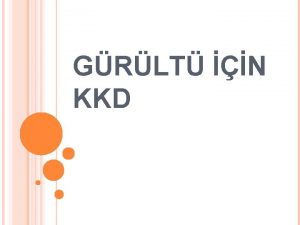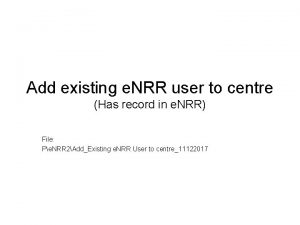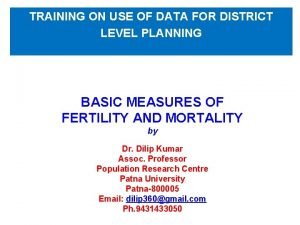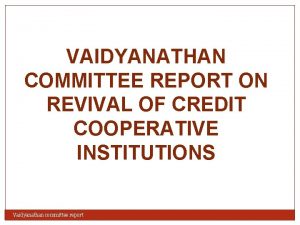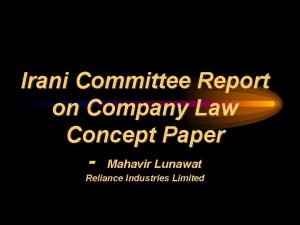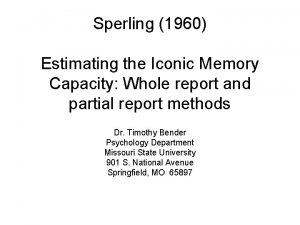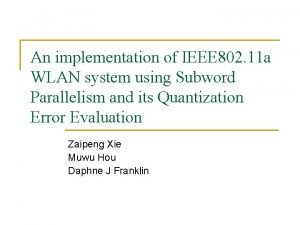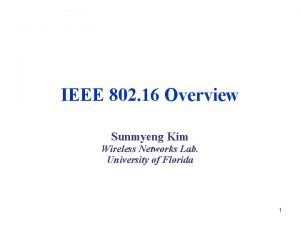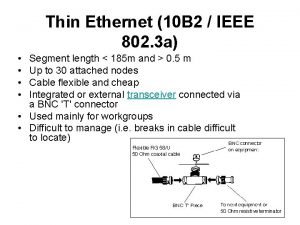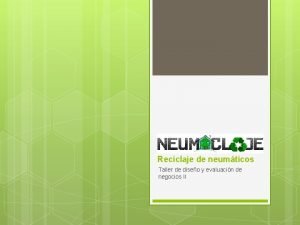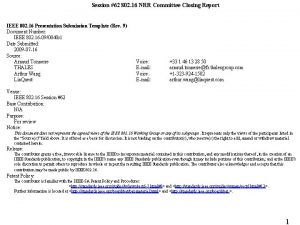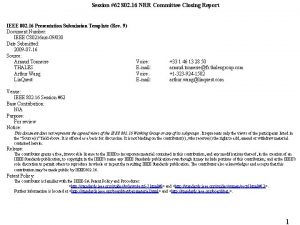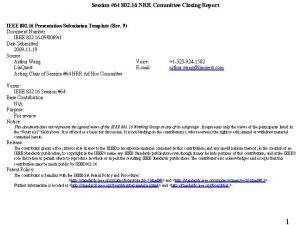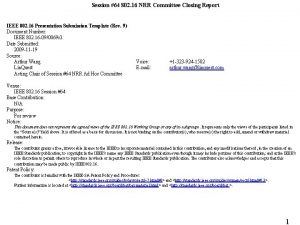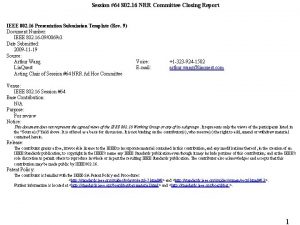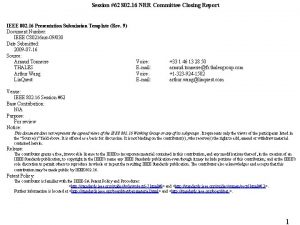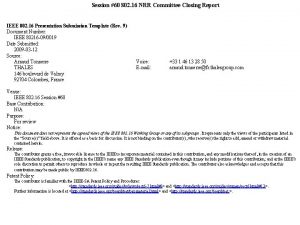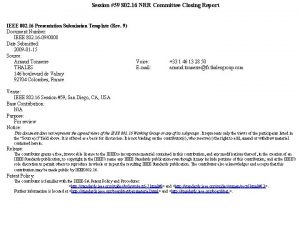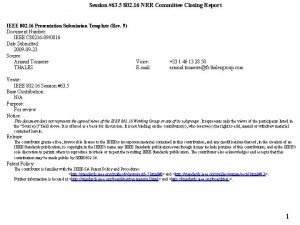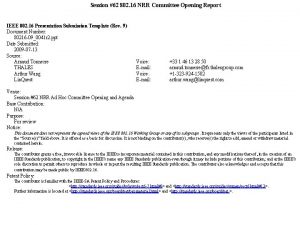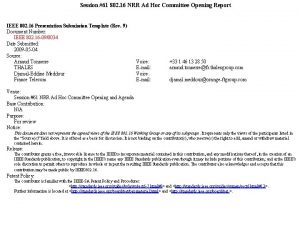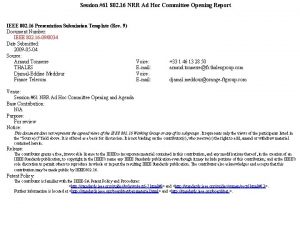Session 60 802 16 NRR Committee Closing Report














![Reference [1] SAFECOM program, “Statement of Requirements for public safety wireless communications and interoperability”, Reference [1] SAFECOM program, “Statement of Requirements for public safety wireless communications and interoperability”,](https://slidetodoc.com/presentation_image_h2/9a67d58fc318db875b86f1c41da3de14/image-15.jpg)
- Slides: 15

Session #60 802. 16 NRR Committee Closing Report IEEE 802. 16 Presentation Submission Template (Rev. 9) Document Number: IEEE 80216 -09/0019 Date Submitted: 2009 -03 -12 Source: Arnaud Tonnerre THALES 146 boulevard de Valmy 92704 Colombes, France Voice: E-mail: +33 1 46 13 28 50 arnaud. tonnerre@fr. thalesgroup. com Venue: IEEE 802. 16 Session #60 Base Contribution: N/A Purpose: For review Notice: This document does not represent the agreed views of the IEEE 802. 16 Working Group or any of its subgroups. It represents only the views of the participants listed in the “Source(s)” field above. It is offered as a basis for discussion. It is not binding on the contributor(s), who reserve(s) the right to add, amend or withdraw material contained herein. Release: The contributor grants a free, irrevocable license to the IEEE to incorporate material contained in this contribution, and any modifications thereof, in the creation of an IEEE Standards publication; to copyright in the IEEE’s name any IEEE Standards publication even though it may include portions of this contribution; and at the IEEE’s sole discretion to permit others to reproduce in whole or in part the resulting IEEE Standards publication. The contributor also acknowledges and accepts that this contribution may be made public by IEEE 802. 16. Patent Policy: The contributor is familiar with the IEEE-SA Patent Policy and Procedures: <http: //standards. ieee. org/guides/bylaws/sect 6 -7. html#6> and <http: //standards. ieee. org/guides/opman/sect 6. html#6. 3>. Further information is located at <http: //standards. ieee. org/board/pat-material. html> and <http: //standards. ieee. org/board/pat >.

Session #60 NRR Working Group Ad Hoc Committee Closing Report March 12, 2009

NRR WG Ad Hoc Committee • A call for interest has been issued at the closing plenary during the November meeting in Dallas – http: //ieee 802. org/16/docs/08/C 80216 -08_028. ppt • The 802. 16 Working Group has approved the creation of a WG Ad Hoc Committee with the objective of promoting discussion on robustness and reliability • A Committee reflector has been created: – http: //dot 16 nrr-reflector. wirelessman. org • A dedicated folder is available in the Member’s upload area: – http: //dot 16 nrr. wirelessman. org

Motivations: Broadband LMR • Land Mobile Radio (LMR or PMR) – Systems used by first responders, companies, public works organizations, transportation, etc. – Highly-reliable technologies but low-rate data services – Significant needs for Broadband services • LMR evolution to Broadband – Short/mid-term: • “Limited” increase of data capacity (TEDS in TETRA) • Complementary use of LMR systems and Broadband technologies – Long-term: Convergence between Broadband LMR technologies • TETRA Association see 802. 16 as a potential candidate for Broadband LMR – 802. 16 is a good basis to build such a Broadband solution – Nevertheless 802. 16 would require enhancements in security, reliability, resilience and group management [3] [4] [5]

Motivations: Public Safety • Related usage models – Public Safety Wireless Networks – Disaster usage models – Surveillance or critical infrastructure, border surveillance • Major requirement: not infrastructure dependent – Expressed in the SAFECOM’s Statement of Requirements for wireless communications (US Department of Homeland Security) [1] – Temporary absence of infrastructure • The infrastructure is damaged or not available • Systems shall allow continued operation in the absence of infrastructure – Non-constructive situation • There is no established infrastructure • Temporary network creation

Motivation: Aviation • Aviation use cases for deterministic and robust systems – General • Suitable COTS hardware that is amenable to aviation application • Aviation has stringent performance requirements than most systems designs – Airport Surface Operations (ASO) • 802. 16 has been recommended by the FAA and Eurocontrol • ASO requires high-reliability for safety critical data transmission – Airplane communications • wireless link may replace a large number of cables (e. g. engine monitors and systems controls) • Requirements: real-time, high-bandwidth, high-reliability

Requirements Usage models requirements 802. 16 limitations Efficient broadcast/multicast of voice and data to groups of individual No efficient subscriber multicast capability exists in 802. 16 today Need for direct communication without the presence of existing infrastructure (SAFECOM So. R for Public Safety [1]) No mode exists in 802. 16 that permits such type of communication If an infrastructure is damaged (a BS or RS fails) the network shall continue to operate (SAFECOM So. R for Public Safety [1]) In 802. 16, the Base Station is a Single-Point -Of-Failure Very low end-to-end delays and call set up times are required for Public Safety and Aviation usage models Priority bandwidth request is not provided The identified usage models require Mobile Base Station capability No specific support for Mobile BS Very high security requirements when critical data are transmitted and human lives are involved Security may require some enhancements (to be confirmed)

Proposed Scope • The scope has been discussed this week – Identification of the studies to be carried out in the Committee – Association with a priority level (1 or 2) • Proposed scope – – – Enhanced relay operation: Direct communication mode: Priority bandwidth request: Non-standard channel behaviors: Enhanced security: Dynamic reconfigurability Level 1 Level 2 (role reversal between stations) – Mobile BS: – Group management: Level 2

Context • Main differences between 802. 16 m and NRR – Primary focus of 802. 16 m is to “meet the cellular layer requirements of IMT-Advanced next generation mobile networks” (TGm PAR) – NRR primary focus is professional and government applications – 802. 16 m leads to cost-driven and spectrum efficient solutions – NRR interest is to increase the reliability of the air interface and to address non-cellular needs – The 802. 16 m standard is intended to be a candidate for consideration in the IMT-Advanced evaluation process – NRR intends to address non IMT-Advanced applications

Context • Status of 802. 16 m – The project must follow a strict timeline in relation to the ITU planning – The consideration of additional requirements and features for non-cellular applications would be inappropriate (time and resource consuming) • Status of NRR – The activity is in its early stage – The Committee needs to define clearly the usage models, requirements and potential solutions – NRR cannot meet the ITU schedule

Context • NRR Committee proposed approach – It seems to be inappropriate to propose NRR requirements to 802. 16 m • Primary applications/usage models are clearly different • Consideration of those requirements may impact the 802. 16 m planning • ITU planning is too tight for development of NRR features – Keep a separate activity • Finish the work for providing recommendations to the Working Group – Work closely with TGm (establish a liaison)

Activities of the week • 2 sessions have been planned during the week – Wednesday morning (9: 10 – 12: 05 pm) – Wednesday afternoon (1: 30 – 3: 45 pm) • Results – Attendees : up to 14 – Represented companies: Thales, Lin. Quest, EADS, France Telecom, Boeing, Mitsubishi, Nokia, BAE Systems, … – 10 presentations have been provided

Activities of the week • Review of NRR overview contribution (C 80216 nrr-09_011) • Presentations related to usage models – – – Aviation usage models (Frank Whetten – Boeing) Usage models needing local forwarding (Yi-Hsueh Tsai – III) Surveillance and disaster applications (Arthur Wang – Lin. Quest) Reconfigurable backhauling (Djamal Meddour – France Telecom) Surveillance scenario (DJ Shyy – MITRE) • Presentation related to the requirements – Resilience and reliability (Arthur Wang – Lin. Quest) – Spectrum issues (Ranga Reddy – US Army) – Mobile BS and enhanced relay (DJ Shyy – MITRE)

Proposed following activities • The Committee has identified significant interests from equipment manufacturers, government organisations and operators • Continue the work as a separate activity – May work closely with TGm • Proposed activities in-between session #60 and #61 – Discussion on the reflector and one conference call
![Reference 1 SAFECOM program Statement of Requirements for public safety wireless communications and interoperability Reference [1] SAFECOM program, “Statement of Requirements for public safety wireless communications and interoperability”,](https://slidetodoc.com/presentation_image_h2/9a67d58fc318db875b86f1c41da3de14/image-15.jpg)
Reference [1] SAFECOM program, “Statement of Requirements for public safety wireless communications and interoperability”, April 2004 [2] “LMR evolution to Broadband”, C 80216 -08/002, Arnaud Tonnerre (THALES), December 2008 [3] “TETRA and Wi. MAX: Complementary or competing ? ”, Marco Morresi, Enrico Donnini (Selex), www. tetramou. com [4] “The market positionning of TETRA”, Devdarsh Jain (Artevea Digital Limited), www. tetramou. com [5] “Wi. MAX, what is it and what can it offer to the mission critical business case ? ”, Pierre Force (EADS), TETRA Association members Workshop, 4 November 2008 [6] Dr. M. Nouri, Chairman of ETSI TC-TETRA WG 4 (High Speed Data), “Broadband wide-coverage, emergency mobile communication”, ICWMMN, October 2008, Beijing, China
 Bridges from 802.x to 802.y
Bridges from 802.x to 802.y Bridges from 802.x to 802.y
Bridges from 802.x to 802.y Kulak koruyucularının ambalaj üzerinde nrr veya snr
Kulak koruyucularının ambalaj üzerinde nrr veya snr Contoh soal nrr
Contoh soal nrr E nrr
E nrr Net reproduction rate
Net reproduction rate Role of remuneration committee in corporate governance ppt
Role of remuneration committee in corporate governance ppt Learning without burden yashpal committee report
Learning without burden yashpal committee report Vaidyanathan committee report relates to revival of
Vaidyanathan committee report relates to revival of Recommendations of jj irani committee
Recommendations of jj irani committee Status progress report
Status progress report Sperling 1960 iconic memory
Sperling 1960 iconic memory Wlan 802
Wlan 802 Modulation coding scheme
Modulation coding scheme 802-3-ethernet
802-3-ethernet 507-802-380
507-802-380


